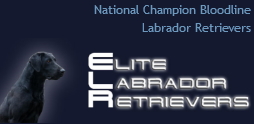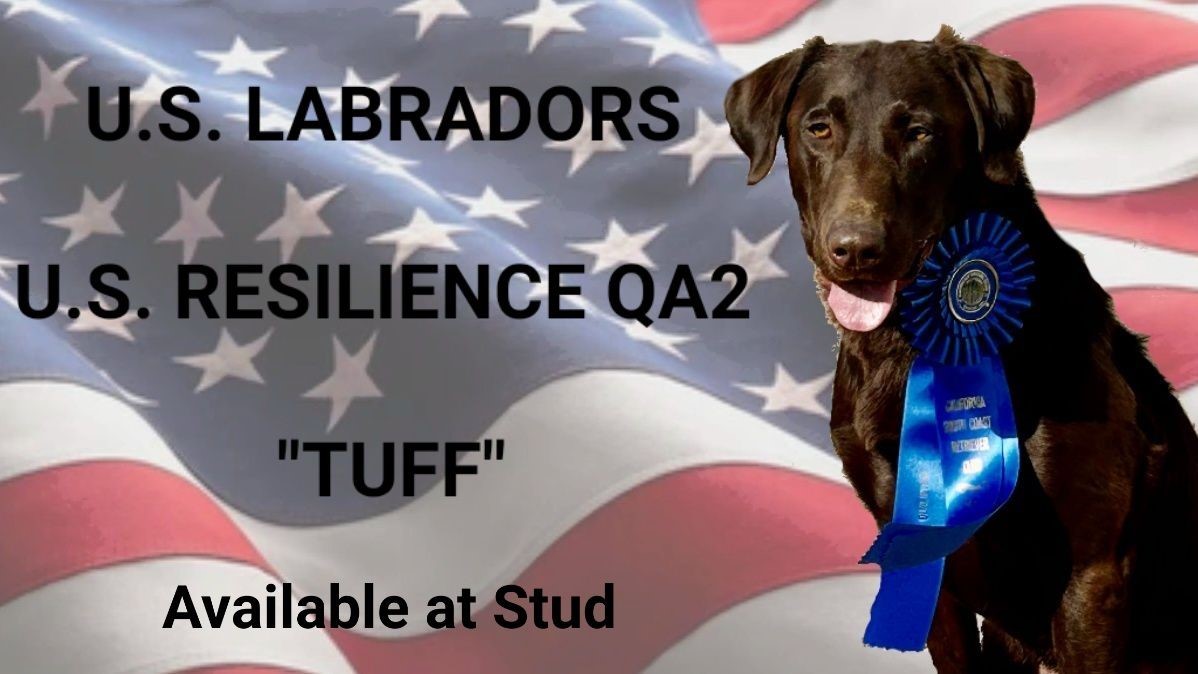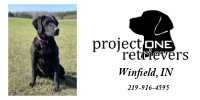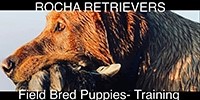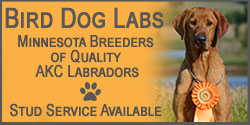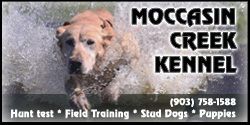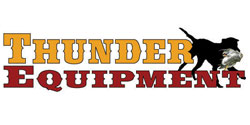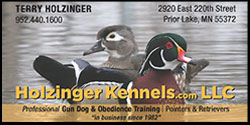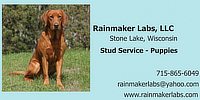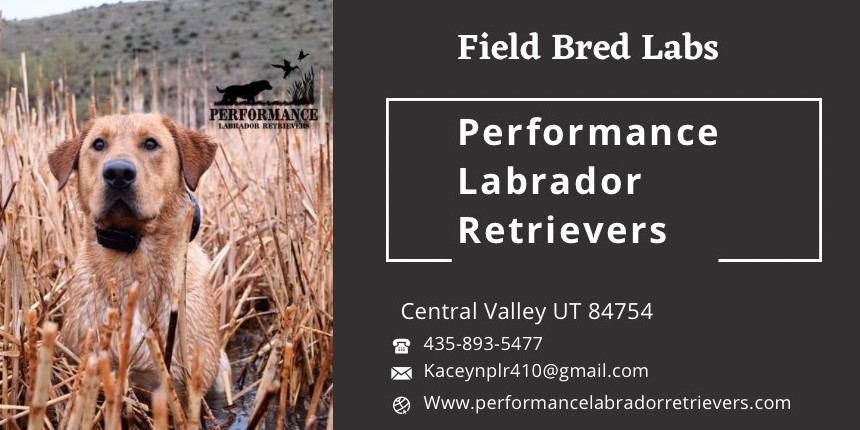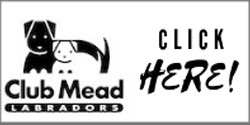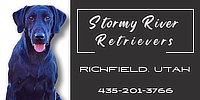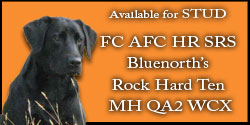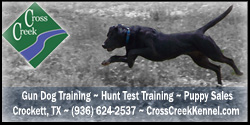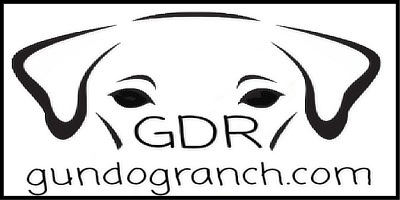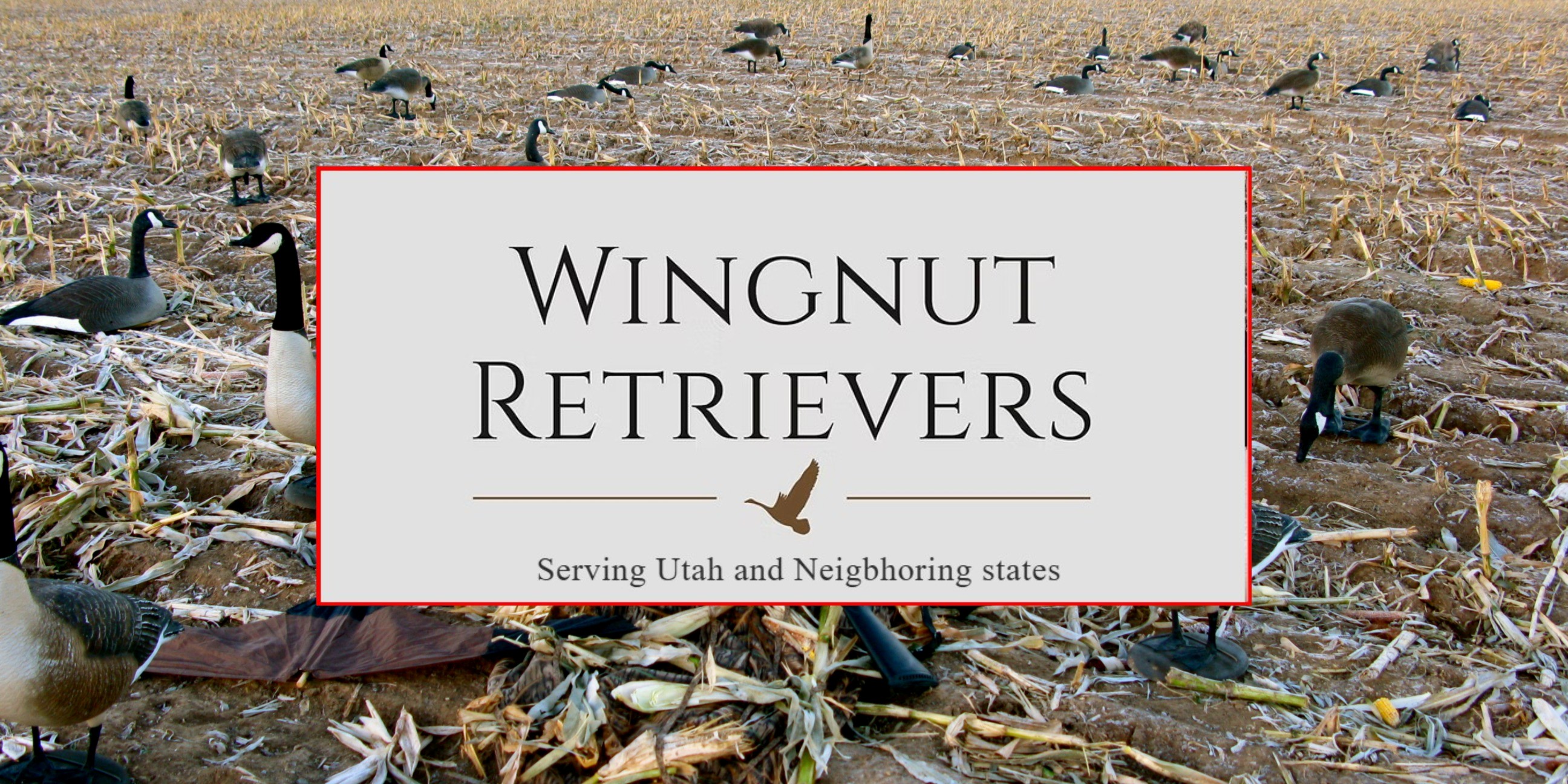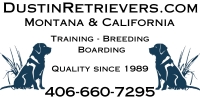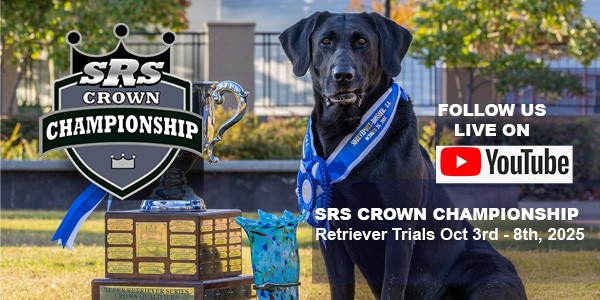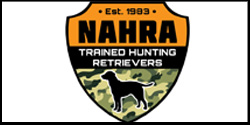| Lord Knutsford's First Labrador
Registration: KCSB 1320J
The Early Labradors
"There is not a living equal in the canine race"
(Notes from the Stud Book of the Duke of Buccleuch's Labrador Retrievers)
The kennels of the Dukes of Buccleuch and the Earls of Malmesbury warrant a special place of recognition in the history of the Labrador. The earliest pedigrees of the dogs owned by Lord Knutsford and the other landowners who took Labradors to their hearts, all included Buccleuch and Malmesbury dogs. Indeed, Lord Knutsford's first Labrador, Sybil (1884) was a great-granddaughter of a dog owned by the 5th Duke of Buccleuch.
The 5th Duke of Buccleuch owned Labradors in the mid 19th century. It is recorded that in about 1825 or 1830, as a result of trade between Newfoundland and Poole Harbour, the Duke, his brother Lord John Scott, the Earl of Malmesbury, the Earl of Home and Mr Radclyffe, all imported the dogs. The book reveals “The 5th Duke of Buccleuch, in 1839 took his Labrador ‘Moss’ in his yacht out to Naples. Lord Home, who was with him took out his Labrador, ‘Drake’.
Colonel Hawker, the celebrated wildfowler and one of the foremost shooters of his time, owner a schooner which plied between Poole and Newfoundland; he is quoted in 1830, comparing the Labrador dogs with the Newfoundland dogs:
(The Labrador is) by far the best for any kind of shooting, he is generally black and no bigger than a pointer, very fine in legs, with short smooth hair and does not carry his tail so much curled as the other, is extremely quick running, swimming and fighting ……chiefly used on the native coast by fishermen. Their sense of smell is hardly to be credited; in finding wounded game there is not a living equal in the canine race.”
The 2nd Earl of Malmesbury (1778-1841) imported Labradors to Heron Court and kept the breed until his death. The 3rd Earl (1807-1889) continued to import and breedthem. The 3rd Earl wrote to the 6th Duke of Buccleuch in 1887 saying:
We always call mine Labrador dogs and I have kept the breed as pure as I could from the first I had from Poole. ……The real breed may be known by their having a close coat which turns the water off like oil and, above all, a tail like an otter.”
The dogs belonging to Lord Malmesbury were described thus:
“Small, compact and very active; their coats were short, thick and smooth with sometimes a brown tinge at certain seasons. The eyes of most were in colour, something like burnt sugar. Their heads, which were not big, were broad and the skull shapely and not long in muzzle. Their bright countenances denoted their sweet tempers and high courage.”
It is also recorded:
“The 6th Duke of Buccleuch and the 12th Earl of Home spent some winters at Bournemouth in the early 1880’s and were amazed, when shooting at Heron Court at the work of Lord Malmesbury’s dogs, especially in water. Lord Malmesbury gave them some of his breed. When (the first dog) Ned (Malmesbury’s Sweep ex M. June, 1882) arrived at Langholm Lodge, he proved himself o a different category to any of the other dogs there. Whereas Avon (Malmesbury’s Tramp ex M. Juno, 1885) was even beter than Ned. All the Buccleuch breed trace back to these two dogs.”
Careful matings with the Duke of Hamilton’s Sam and Sir Frederick Graham’s Netherby Kielder brought in blood from the 5th Duke’s original Labradors and thus a strong Early Labradors bloodline was developed. Lord George Scott, younger son of the 6th Duke, took over the management of the Buccleuch Labradors in 1888. There were, at that time, more than 60 gamekeepers on the various estates and starting from these sound foundations, within a few years all were provided with one or more dogs. Keepers were responsible for training and looking after their own dogs, but all matings were arranged by Lord George. No dog was ever sold, but some were given to relations or friends of the family.
In the 1880’s trade with Newfoundland ceased and with it the importation of Labradors. At the same time 135 districts in the Island decided to ban the keeping of all dogs. This meant almost total destruction of the breed in the island, but in the 1930’s a few of the old breed were found in remoter areas and five were brought back to Scotland.
The 2nd World War meant the drastic running down of the Buccleuch Kennel. Lord George died and subsequently, outside blood had to be introduced to keep the line going.
The kennels of the Earls of Malmesbury, having been established early in the 19th century, continued for almost 100 years. The impact of the Malmesbury dogs Sweep (1877) and Tramp (1879) when mated to M. Juno (1878) can clearly be found in the early pedigrees. Indeed, the line down from Tramp includes such dogs as Munden Sentry and Single, FT Ch Peter of Faskally, FTCh Tag of Whitmore and Dual Ch Banchory Bolo. Sweep’s line includes the legendary Flapper. Sadly the direct line from the original imported dogs came to an end during the 1914-1918 war.
Neither the Buccleuch dogs nor the Malmsbury dogs ever appeared in competition. It is however, from the careful and dedicated importation and breeding of these kennels and that of the Radclyffe family, in the earliest days of the breed’s history, that the bloodlines of the pure bred Labrador became established in this country.
A deep debt of gratitude must go to the Dukes of Buccleuch and the Earls of Malmesbury and others like them, who first recognised the special qualities of the Labrador and passed on such a rich inheritance for all lovers of the Labrador to enjoy.
Jo Coulson
Today Buccleuch gundogs are competing in Field Trials by Gundog Trainer, David Lissett. Further details can be found on the Drumlandrig website.
https://thelabradorretrieverclub.com/early-labradors
LORD KNUTSFORD
Chairman 1916 - 1935
Lord Knutsford took office as the Club Chairman in 1916 (as the Hon Arthur Holland-Hibbert) and continued at the helm until his death in 1935. Much credit must go to him for his diplomatic Chairmanship during the formative years of the breed and also for his own place as a Labrador breeder of note.
Lord Knutsford acquired his first Labrador in 1884, Sybil, a bitch closely bred back to Netherby Boatswain was described as a ‘wonderful good bitch, nose, pace, endurance and marking’. She was mated to a dog from Lord Malmesbury’s kennel and thus the Munden line began. Munden Sixty, the result of a mating between Munden Sarah (a Sybil granddaughter) and the Duke of Buccleuch’s Nith (a Malmesbury Tramp grandson), born in 1897 was a much loved dog. When he died Lord Knutsford wrote ’To the everlasting grief of all who knew him, this splendid dog died in August 1907’. Sixty was the sire of a bitch which was to become perhaps the most famous of all the early Labradors, for it was she, Munden Single, whose impact on the field trial world would change the pattern of working gundogs for all time.
Munden Single was born in 1899, her mother, Munden Scottie, had been acquired from the Duke of Buccleuch’s kennel. Her breeding was therefore almost pure Buccleuch and Malmesbury. Single was destined to forge a path both at field trials and shows which all others have sought to follow subsequently. Single had already won prizes in the show ring, including a CC at the KC Show, when, in 1904, she was entered in the IGL field trial at Sherbourne. As the first Labrador ever to appear at a field trial naturally she was closely observed by all.
The newspapers of the day recorded:
Only those who were at the Meeting know how every nearly the Stake was carried off by the finest Labrador bitch ever seen on or off the bench. We refer to the Hon Mr Holland-Hibbert’s blue blooded Munden Single - up to a certain point nothing could have stopped her winning the highest honours at the trial. One of the best shots in England, a man who has handled retrievers all his life, declared to us that Single was the best game-finder and the steadiest retriever he had ever seen.
Sadly, she was not to win, she mouthed a bird when bringing it to hand. Lord Knutsford wrote in his record book ‘she was too gross and I was to blame for not getting her finer. She was out of breath after a strong runner and resented its struggles’. Single had however, done enough, Labradors were on the map well and truly. She won a CoM at that trial and went on to win others and continued to win well on the bench. When she died in 1909, her body was preserved and put on display, it is believed still to be held in a museum vault. Lord Knutsford wrote ‘It is a bad representation’.
Lord Knutsford regularly showed his dogs in the early days and enjoyed some considerable success. In 1904 he won the first bitch CC ever awarded with Munden Single and Munden Sentry won the only dog CC awarded in 1905. In 1909 Munden Sooty won two CC’s at Crufts and Darlington. In fact, during the first six years, when a total of 29 CC’s were available, dogs owned by Lord Knutsford, or bred from Munden dogs, won 15 CC’s.
There were many successful litters bred over the 50 years that Lord Knutsford kept Labradors. Although they are too numerous to mention individually, one litter must be recorded. In 1923 Munden Scarcity was mated to Dual Ch Banchory Bolo; there were six surviving puppies. Lord Knutsford kept two, Solo, a dog and Singer, a bitch; a bitch was given to His Majesty the King and a dog went to Lady Howe. Lady Howe’s puppy turned out to be Ch Banchory Danilo, a dog described by Lord Knutsford as ‘winning more championships than any dog ever known - or nearly so.’ Munden Solo also did well at shows, at Crufts in 1927 he was entered in 10 classes, won 6, was second in 2 and third in another. The judge wrote of him ‘if there had been a little more of him in size, I think he would have been very near perfection.’
Lord Knutsford was a great protector of the breed, he frequently went into print to defend the Labrador. There were constant disputes as to the breed’s origins and Lord Knutsford was tireless in his endeavours to get to the true beginnings. There are nots of conversations with Major Radclyffe and Mr Stuart-Menzies and letters to and from other early breeders. His kennel records describe dogs variously as being Newfoundland-type, Labrador-type long and rough coated, smooth coated and frequently they had white markings.
Like so many other kennels, Munden had to endure a number of serious distemper outbreaks. Many promising puppies and indeed some good adults were lost. Lord Knutsford worked very hard to find a solution to the scourge. Having had little success in his approaches to the Ministry of Agriculture and the Royal Veterinary College, he finally persuaded the Editor of The Field to set up an investigation into the disease. Funds were raised, the research was successful and a vaccine was eventually produced in 1929. The Daily Telegraph newspaper of that year reported that two vaccines were now available, albeit in very small supplies. The report went on ... ... ‘dog owners have every reason to be grateful to Mr Holland Hibbert for the idea and to the great sporting newspaper for the manner in which it has been made possible.’
It is fitting that the life of this dedicated gentleman came to an end at a Club field trial at Idsworth in 1935. He collapsed whilst making his traditional speech to the Members. Lady Knutsford wrote later to Lady Howe, that she was thankful that his death had taken place at Idsworth amongst friends so deeply attached to him.
I am indebted to the present Lord Knutsford and to the Holland-Hibbert family, who still live at Munden, for allowing me access to Lord Knutsford’s personal kennel records. I am pleased to record that there are still Labradors owned by the family, at Munden.
Jo Coulson, 1991
https://thelabradorretrieverclub.com/knutsford
|
